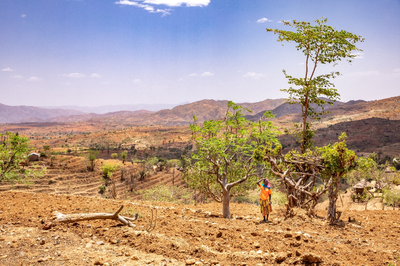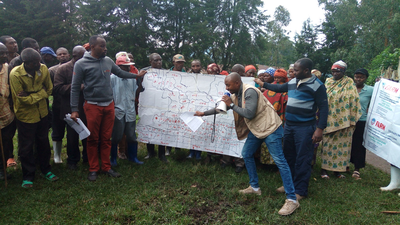The evidence is clear: climate finance is not going to the most climate-vulnerable countries and populations. The majority of the most climate-vulnerable countries received less than $20 per person per year in climate change adaptation financing from 2010–2017.
This is particularly troubling as climate change is already affecting the lives and livelihoods of communities in climate-vulnerable countries, especially in fragile states. For example, from 2004-2014, 58% of disaster-related deaths occurred in the top 30 fragile and conflict-affected countries.

The Green Climate Fund (GCF) is the world’s largest dedicated fund of the United Nations Framework Convention on Climate Change (UNFCCC) and is an essential channel for directing urgent climate change funding to front line communities and climate-vulnerable countries.
The GCF’s commitment to allocate 50% of its funding to adaptation programming, and 50% of those funds to priority countries like the Least Developed Countries (LDC), Small Island Developing States (SIDS), and African States, is a commendable goal.
As of November 2020, $2.63 billion (36% of the GCF portfolio) has reached these countries. This is a good start for helping countries affected by climate change.
Adaptation finance is not reaching those most in need
However, if we look at where funds are going within these broad groups of states, there are deep disparities that must be addressed. For example, GCF funding by indicators of climate vulnerability suggests a disturbing trend for the most climate-vulnerable countries. To compound this problem, many of these most climate-vulnerable countries also fall into the category of “fragile states.”
These countries are particularly in need of support to combat the effects of climate change, which overlay and compound existing challenges in terms of governance, security, and poverty. Specifically:
- Within the top-25 most climate-vulnerable countries, as ranked by the ND-GAIN Index (and which overlap closely with highly fragile states, as indicated by the Fragile States Index), only 9 single-country adaptation projects have been approved by the GCF (total of USD $258.1 million). This is out of a total of 60 single-country adaptation projects approved by the GCF globally;
- The average amount of adaptation funding for the top-25 most climate-vulnerable countries is USD $10.3 million, compared to USD $32.5 million within states ranked 26-70 for climate vulnerability.
This indicates that GCF financing is often not being directed to the countries most vulnerable to climate change, including fragile states.
Adaptation finance must be allocated according to vulnerability
In the Updated Strategic Plan, the GCF committed to allocate a minimum of 69% of its resources to adaptation programming. This is an exciting 19% increase. But as we’ve already discussed, allocating adaptation funding to priority countries does not automatically mean funding is going to the most climate-vulnerable countries and by extension, fragile states.
To really address the needs of countries most at risk to climate change, the GCF must allocate its adaptation finance according to climate vulnerability. This will close the gap in adaptation finance directed to climate-vulnerable countries and fragile states.
Why invest in climate vulnerable countries and fragile states
There is a ‘triple dividend’ of investing in adaptation and resilience, which ensures scarce resources create the widest benefits including reducing disaster losses, unlocking development potential, and fostering wider social and environmental co-benefits.
Given the GCF’s emphasis on transformational climate-sensitive investments, investing in climate change adaptation makes economic sense, and will help climate-vulnerable countries build resilience to future crises.
These investments are needed globally, but particularly in climate-vulnerable countries and fragile states, which are not only highly vulnerable to the impacts of climate change but also have a low readiness to respond. For example, the Democratic Republic of Congo (DRC) ranks 177 out of 181 on the ND-GAIN index and is plagued by protracted humanitarian crises, particularly in the east, which has experienced more than two decades of violence and mass displacement.
What success can look like: an example from Mercy Corps
Programming in fragile, climate-vulnerable states is possible, but interventions must take local drivers of conflict into account. An example of programming that adopts conflict-sensitive approaches is Mercy Corps’ Food Security and Inclusive Access to Resources for Conflict-Sensitive Market Development Program (FARM). Funded by the Dutch government, the program is designed to improve food security and socioeconomic conditions in 19 villages in North Kivu and alleviate pressures on the local environment.
The FARM program uses sophisticated ecosystem modeling technologies that help communities come together to make strategic investments to improve their local environmental conditions, reducing disaster risk and building social cohesion simultaneously.
A technical partner in the program, EcoMetric Solutions Group (ESG), led an Environment and Ecosystems assessment that looked at environmental issues that lead to climate risks and fuel conflict. The analysis provided strategic suggestions to improve environmental conditions with a clear return on investment identified for all stakeholders, enhancing cooperation and reducing conflict, particularly in the agriculture sector.
The FARM program is a concrete example of building adaptive capacity to climate change in vulnerable countries and has the potential to yield the type of paradigm shift the GCF strives for.

We urge the Green Climate Fund to play its role in the lead up to COP26
Without investment, the most climate-vulnerable and fragile countries have little hope of adapting to the potentially devastating effects of climate change already being felt.
The GCF Board must prioritize adaptation funding to the most climate-vulnerable countries and fragile states during this crucial phase of the Fund. By 2030, 2.2 billion people will live in fragile states, which will represent 26% of the total world population.
Investing in adaptation programming in climate-vulnerable fragile states now will increase the ability of these communities to weather the climate threats they will inevitably face.
On the road to COP26, the global community will debate how to increase climate ambition and support those most vulnerable to climate change impacts. The Green Climate Fund has a critical role to play in helping climate-vulnerable countries and fragile states adapt to climate change, and must step up to meet this moment.

Creative children in Arts-clean up Liberia says:
Please invest in the Creative children in Arts-clean up Liberia an Environmental organisation that is engage in tree planting to save the Environment.